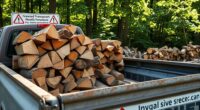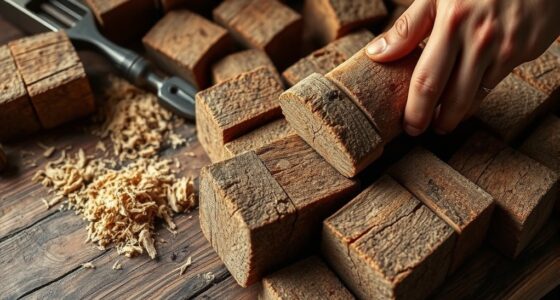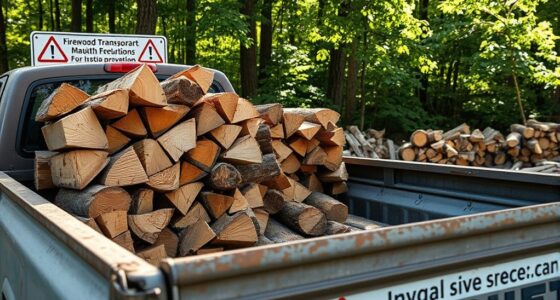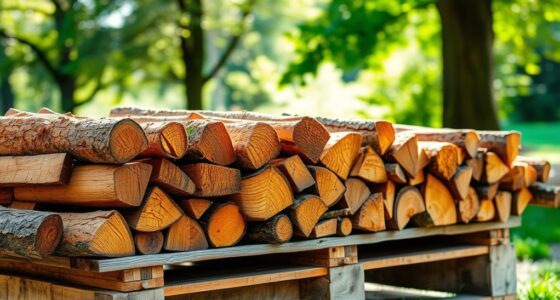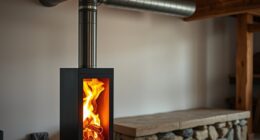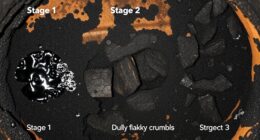Pellet grades and standards help you identify quality biomass products for efficient and clean-burning use. High-grade pellets are made from well-dried, pure materials with low ash and high energy content, while lower grades may contain fillers or moisture. Certification labels ensure these standards are upheld, promoting consistency and environmental friendliness. Understanding these classifications lets you choose the best pellets for your needs and optimize performance—keep exploring to learn more about how these standards impact your choices.
Key Takeaways
- Pellet grades classify quality based on ash content, moisture, durability, and energy output, with standards set by organizations like PFI and EPC.
- Premium pellets are made from pure, well-dried biomass, offering higher density, durability, and cleaner combustion.
- Certification labels and test reports verify that pellets meet specific grade criteria, ensuring consistent quality.
- Manufacturing processes include drying, grinding, compressing, and testing to maintain pellets within standard specifications.
- Higher-grade pellets provide better efficiency, less ash, and environmental benefits, while lower grades may contain binders or residual moisture.
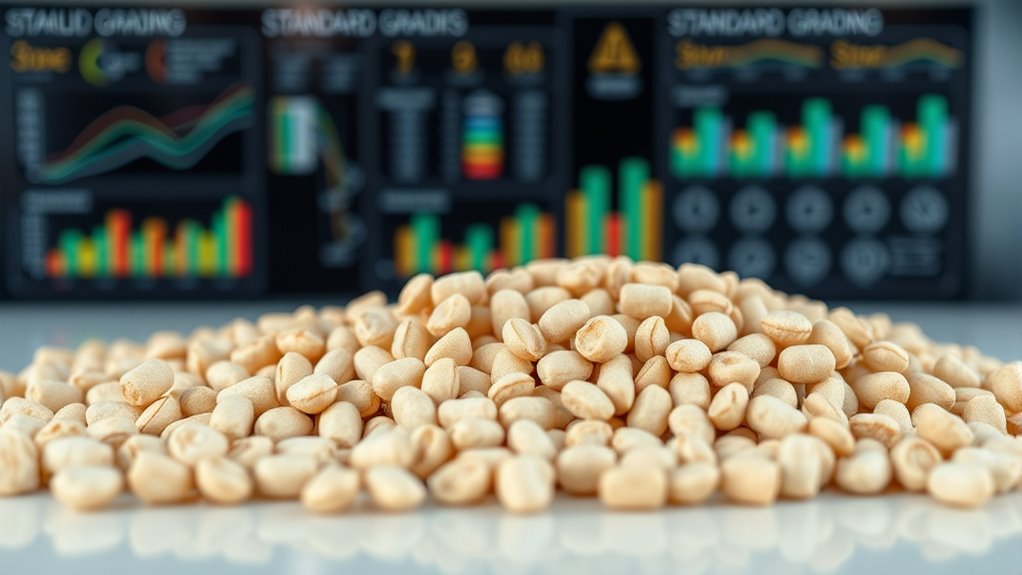
Have you ever wondered how pellet quality is determined? When it comes to biomass fuel, the standards and grades set for pellets play a crucial role in ensuring you get a consistent, efficient, and clean-burning product. The process begins with pellet manufacturing, where raw biomass—like wood, agricultural residues, or other organic materials—is processed into compressed pellets. During this process, many factors influence the final quality, including raw material selection, moisture content, pellet density, and manufacturing techniques. These factors are closely monitored to meet specific standards that classify pellets into different grades.
Pellet grades are established to help consumers and industry professionals distinguish between high-quality and lower-quality biomass fuel. For example, premium pellets are typically made from pure, well-dried raw materials, resulting in a denser, harder pellet that burns efficiently with minimal ash. On the other hand, lower-grade pellets may contain more binders, fillers, or residual moisture, leading to a less consistent burn and increased ash production. Standards set by organizations such as the Pellet Fuels Institute (PFI) or the European Pellet Council (EPC) specify criteria like ash content, moisture level, durability, and calorific value, which directly impact pellet performance.
Pellet grades differentiate high-quality from lower-grade biomass based on ash, moisture, durability, and calorific value standards.
In pellet manufacturing, quality control is vital. It begins with selecting the right biomass feedstock, ensuring it’s free of contaminants, and drying it to optimal moisture levels—usually between 8-10%. The material is then ground into a fine powder, which is compressed through a die under high pressure. This compression forms the pellets, which are cooled and screened for size and density. During this process, manufacturers test samples to verify they meet the standards for their intended grade. These tests check for ash content, tensile strength, and energy output, ensuring each batch aligns with the designated pellet grade. Additionally, advances in sound wave technologies are being explored to evaluate pellet quality through non-destructive testing methods. Implementing rigorous quality control measures ensures consistency and reliability in pellet production, which is essential for consumer trust. Regular testing and certification are also essential for maintaining consistent quality across production batches. Moreover, adopting innovative testing techniques can further enhance the precision of quality assessments, leading to better product standards.
Understanding pellet standards helps you make informed choices. High-quality biomass fuel, such as premium pellets, guarantees cleaner combustion, less maintenance, and better heat output. Lower-grade pellets, while sometimes cheaper, may cause more ash buildup and less efficient burning. That’s why reputable pellet manufacturing companies adhere strictly to established standards, providing transparency and consistency. When selecting pellets, always check for certification labels or test reports. This ensures you’re getting a product that meets the appropriate standards for your needs—whether for residential heating, industrial use, or other applications. Ultimately, knowing how pellet quality is determined empowers you to choose the best biomass fuel, maximizing efficiency and minimizing environmental impact.
Frequently Asked Questions
How Do Different Pellet Grades Affect Boiler Efficiency?
Different pellet grades directly impact your boiler’s efficiency by influencing combustion efficiency and ash content. Higher-grade pellets burn cleaner, with lower ash content, which helps maintain ideal combustion and reduces build-up in your system. Lower-grade pellets may produce more ash and incomplete combustion, decreasing efficiency and increasing maintenance needs. Choosing the right pellet grade ensures you get better heat output, less downtime, and a longer lifespan for your boiler.
Are There Regional Variations in Pellet Standards?
Yes, regional variations in pellet standards exist, affecting regional compliance and quality assurance. You’ll find differences in moisture content, ash levels, and size requirements across areas, reflecting local regulations and resource availability. These variations influence how pellets meet safety and efficiency standards. Staying informed about regional standards helps you select compliant, high-quality pellets, ensuring ideal boiler performance and adherence to local environmental and safety regulations.
What Are the Environmental Impacts of Lower-Grade Pellets?
Lower-grade pellets often produce higher emissions, impacting air quality and contributing to environmental harm. When you burn these pellets, they generate more wood ash and release increased particulate matter and pollutants. This makes emissions control more challenging, as ash disposal and pollutant management become harder. Consequently, using lower-grade pellets can harm ecosystems and human health, emphasizing the importance of selecting higher-quality options to minimize environmental impacts.
How Often Are Pellet Standards Updated?
You might be surprised to learn that pellet standards are typically updated every few years, depending on industry advancements and regulatory changes. When you pursue pellet certification, you guarantee your product meets current standards compliance, which can evolve to address environmental concerns and quality improvements. Staying informed about these updates helps you maintain high-quality pellets, meet certifications, and adapt quickly to new regulations, ultimately giving you a competitive edge in the market.
Can I Mix Different Pellet Grades Safely?
You can mix different pellet grades, but you need to be cautious during pellet storage and transportation. Mixing may affect combustion efficiency and emissions, so check the compatibility of the grades first. Properly segregate and label each grade to prevent contamination. During pellet transportation, secure the different grades separately to avoid cross-contamination. Always follow manufacturer guidelines and standards to guarantee safe handling and peak pellet performance.
Conclusion
Understanding pellet grades and standards is like having a map through a dense forest—you’ll navigate with confidence and avoid pitfalls. By knowing what each grade signifies, you ensure you’re choosing the right quality for your needs. This knowledge acts as your guiding compass, steering you toward efficient, reliable, and safe pellet use. When you’re well-informed, you’re not just wandering aimlessly—you’re confidently sailing through a sea of options, reaching your destination with clarity and purpose.


